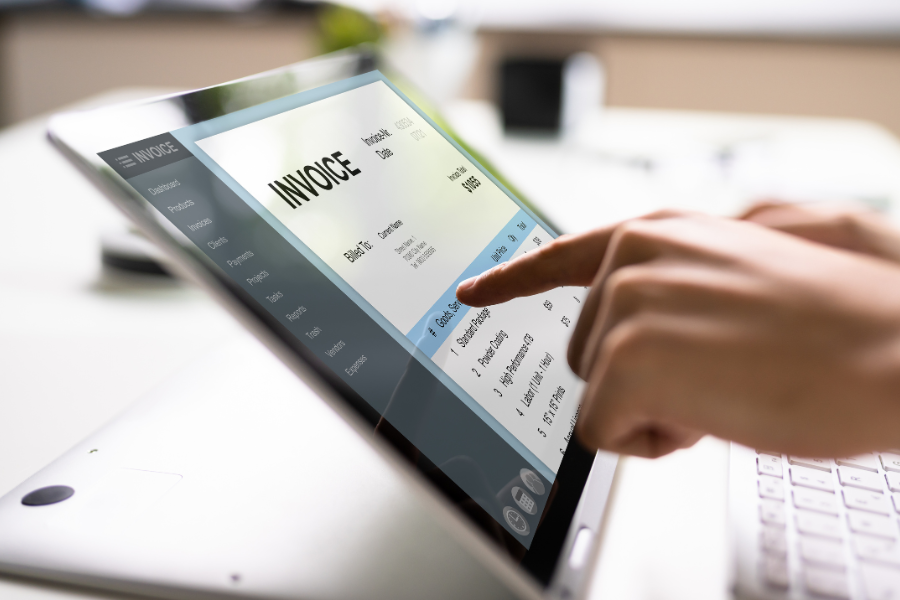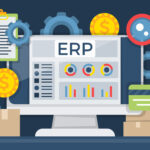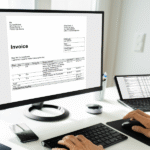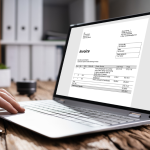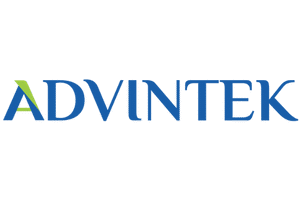Malaysia is digitizing its tax administration with a new e-Invoice system, mandated by the LHDN, to create a more transparent, efficient, and secure tax environment. In June 2025, the LHDN released Version 4.4 of its e-Invoice Guidelines, refining the rollout schedule and clarifying compliance requirements. This move replaces traditional paper invoices with standardized, electronically validated documents, simplifying tax reporting for businesses and making transactions more verifiable for consumers.
Whether you’re a large enterprise or a micro-business, the shift to e-Invoicing will impact your operations. This guide walks you through everything you need to know: what an e-Invoice is, how the system functions, who must comply (and when), and what’s new in the latest LHDN update. We’ll also explain how to submit invoices via the MyInvois Portal or API, what exemptions exist, how SMEs can benefit, and how to prepare your business for a smooth transition.
What is an e-Invoice?
An e-Invoice is a digital proof of a sale or transaction between a supplier and buyer, created and stored electronically instead of on paper. It is generated in a machine-readable format (XML or JSON) as specified by the LHDN, containing fields such as seller/buyer details, items sold, amounts, tax, and a unique reference. By issuing e-Invoices in a standard format, businesses eliminate manual billing errors and paperwork. In essence, each e-Invoice is a secure digital document that is instantly shared and validated by the tax authority. This automation speeds up invoicing and payment processes, supports accurate record-keeping, and makes tax compliance more efficient.
How Malaysia’s e-Invoice System Works
When a transaction occurs, the supplier creates an e-Invoice using either the LHDN’s online MyInvois Portal or through a direct API connection. The e-Invoice is then submitted to LHDN’s system for instant validation. Upon validation, LHDN’s system assigns the invoice a unique ID and embeds a QR code into it. The validated e-Invoice (with its QR code) must be shared with the buyer. Both supplier and buyer receive confirmation from the portal or API when the invoice is verified. If there is an error, either party can void the e-Invoice within 72 hours of validation. This workflow ensures every approved invoice is recorded in real-time with the tax authority, reducing disputes and improving transparency.
Key steps in the process are:
- Generation: Supplier issues the e-Invoice in the prescribed format.
- Submission: The invoice data is submitted to LHDN via the MyInvois Portal or an API call.
- Validation: LHDN’s system instantly checks the invoice. If valid, it returns a unique reference number.
- Notification: Both supplier and customer are notified of the validated invoice.
- Sharing: The supplier shares the finalized e-Invoice (including its QR code) with the buyer.
- Cancellation Window: Either party may cancel/reject the e-Invoice within 72 hours if needed.
This digital process replaces manual invoicing. For example, once validated, the QR code on the invoice lets anyone (supplier or buyer) scan it via MyInvois to confirm the invoice’s authenticity and status. This not only helps businesses cross-check invoices but also gives consumers confidence they are dealing with legitimate documentation.
Who Needs to Comply (and When)
The e-Invoice mandate is being rolled out in phases based on a company’s annual revenue or sales. LHDN has defined several compliance tiers and timelines:
- Phase 1 (Aug 1, 2024): Companies with annual turnover > RM100 million began e-invoicing.
- Phase 2 (Jan 1, 2025): Companies with > RM25 million up to RM100 million turnover.
- Phase 3 (July 1, 2025): Companies with > RM5 million up to RM25 million.
- Phase 4 (Jan 1, 2026): Companies with > RM1 million up to RM5 million.
- Phase 5 (July 1, 2026): Companies with > RM500,000 up to RM1 million.
Businesses with annual sales below RM500,000 are currently exempt from issuing e-Invoices. In other words, micro-sized companies and sole-proprietors with very low turnover do not have to participate for now. Each tier has a 6-month transition period after its start date during which consolidated or batched e-Invoices are allowed, helping businesses adjust gradually. For example, a business in Phase 3 (RM5m–25m revenue) has until December 31, 2025 to fully comply, but can issue consolidated invoices during the grace period.
It’s important to note that the LHDN’s Version 4.4 guidelines (issued 5 June 2025) updated these dates and thresholds. In particular, companies with revenue between RM1m and RM5m are now required to e-invoice by Jan 1, 2026, and those up to RM1m by July 1, 2026. The earlier assumption that all taxpayers must comply by mid-2025 was relaxed to give small businesses more time. In summary, medium and large businesses must start e-invoicing sooner, while the smallest businesses have later deadlines or exemption.
What’s New in Guideline 4.4
The LHDN’s latest e-Invoice Guideline (Version 4.4) reflects these changes:
- Extended Timelines: As noted, businesses with RM500k–RM1m revenue now have a compliance date of 1 July 2026, and those ≤RM500k remain exempt. The RM10,000 transaction rule takes effect on 1 Jan 2026 (see below).
- Exemption Increased: The small-business exemption threshold was raised. Now, any business with annual sales below RM500,000 is not required to e-invoice for the time being. This protects micro-entrepreneurs from immediate burden.
- Consolidated Invoices Rule: Starting Jan 1, 2026, LHDN requires an individual e-Invoice for every sale exceeding RM10,000. In other words, consolidated or batch invoices are no longer allowed for large transactions. This change encourages detailed record-keeping for high-value sales.
- Clarifications & Technical Updates: Version 4.4 also clarifies formats and scenarios. For example, it confirms that self-billing (a buyer issuing an invoice on behalf of a supplier) and corrections are handled under the e-Invoice system. Any foreign or non-business transactions (like salary payments, pensions, alimony, etc.) are explicitly outside the e-invoicing scope. The new guideline refines definitions and provides updated code lists (such as tax types) for system developers.
These updates mean small and medium businesses have breathing room. However, larger companies should be fully transitioned by mid-2025. All businesses should review the Version 4.4 guideline details (available on the LHDN website) to ensure their software and processes meet the new requirements.
How to Submit an e-Invoice: Portal vs API
Taxpayers have two ways to issue e-Invoices to LHDN:
- MyInvois Portal (Web Interface): This is LHDN’s free online portal. Any business can register and use it to manually create invoices or upload batches via a spreadsheet template. It’s user-friendly and doesn’t require coding. Small businesses and retailers often prefer the portal because there is no cost and no technical setup. The portal is accessible from any browser and can handle bulk uploads, making it fairly efficient for moderate volumes.
- API Integration: Larger businesses or those with high transaction volumes can integrate their billing or ERP system directly with LHDN’s e-Invoicing API. This requires programming and possible initial investment in IT (or using middleware services). Once set up, invoices flow automatically from the company’s accounting system to LHDN in real time. The API offers direct transmission, which is ideal for companies issuing large numbers of invoices. Third-party software vendors and ERP providers are already building these connections for clients.
When choosing, businesses should consider volume and resources. The portal is simple and free – great for micro and small enterprises. API integration is more complex but eliminates manual data entry and is faster for large invoice volumes. In either case, the LHDN system checks and validates each e-Invoice.
Step-by-Step Submission via Portal:
- Prepare Invoice Data: Use your existing billing system to generate the invoice details. Ensure all fields match LHDN’s requirements (55 fields as per the guideline).
- Log In to MyInvois: Use your business tax ID to access the portal. If you haven’t registered yet, do so early to avoid delays.
- Create or Upload Invoice: You can type invoice details directly into the portal’s form, or use the bulk-upload feature. LHDN provides a spreadsheet template for batch uploads.
- Submit for Validation: Once entered, submit the invoice. The system will instantly validate the data.
- Receive Reference & Share Invoice: If approved, a unique e-Invoice reference number is generated and a QR code is embedded. Download or view the finalized e-Invoice and share it with your customer.
- Monitor & Manage: The portal lets you track submitted invoices and manage any cancellations.
Using the API:
Businesses opting for API integration will follow a similar logic but through software:
- After registering for API access and obtaining credentials, your system constructs the e-Invoice data in XML/JSON format.
- Send the data via the e-Invois API endpoint.
- LHDN’s API responds with validation results (success or errors).
- On success, the e-Invoice reference and QR code are returned.
- Your system must then send the final invoice to the customer (often by email or EDI).
In both methods, LHDN’s backend keeps a record of all validated e-Invoices. Suppliers and buyers can query their own e-Invoice history through the portal or API. This ensures a clear audit trail.
Exemptions and Special Cases
Not all taxpayers must use e-Invoices. The guidelines list specific exemptions:
- Very Small Businesses: As noted, taxpayers with annual sales up to RM500,000 are exempt (no obligation) under current rules. This exemption applies provided the business is not part of a larger group with higher revenue.
- Non-business Entities: Individuals who do not carry on a business, and certain statutory bodies or local authorities in relation to government-related transactions, are exempt. For example, a foreign diplomatic mission does not need to issue e-Invoices.
- Certain Transactions: Some transactions are outside e-invoice scope. These include employment income (salaries), pensions, alimony/maintenance payments, and other private payments. Also, sales of goods or services performed before the compliance date (e.g. before 1 July 2025) are not subject to e-invoicing.
- Exports and Foreign Sales: Generally, B2B or B2C exports are also covered by the e-Invoice rules (since they are commercial transactions). However, if the buyer is outside Malaysia and no GST is involved, businesses should still issue an e-Invoice and report it. The e-Invoice system does not distinguish domestic vs. export transactions in terms of mandatory use.
These exemptions mean that many casual or hobby businesses need not worry about e-invoicing. However, any income considered “business revenue” counts toward your threshold. It’s wise to check the LHDN guidelines or consult a tax professional if you’re unsure whether an entity or transaction is exempt.
Benefits for Businesses and Consumers
The shift to e-Invoice Malaysia brings many advantages:
- For Small Businesses: E-Invoicing automates billing, reducing errors and labor. Paperless invoices mean lower costs for printing, postage, or travel. With invoices validated on-the-fly, businesses can improve cash flow and shorten payment cycles. Electronic records also make bookkeeping simpler – everything is timestamped and stored digitally. Importantly, compliance is easier: the system automatically aligns with tax rules, helping businesses stay on the right side of tax compliance. As the LHDN notes, e-Invoicing will streamline processes, reduce paperwork, and strengthen the digital economy. Accurate electronic invoices mean less chance of disputes or audits over missing or duplicate invoices.
- For Consumers and Customers: When you buy from a business, an e-Invoice provides immediate proof of purchase. The QR code feature allows consumers to verify the invoice via the MyInvois system, ensuring it’s genuine. This reduces fraud and makes returns or warranty claims easier, since retailers can instantly retrieve the sales record. Consumers benefit from the convenience of receiving digital invoices by email or SMS instead of paper receipts. In the broader sense, a more efficient and fair tax system (with fewer leaks) helps improve public services.
In summary, e-Invoicing brings speed, accuracy and transparency. For small business owners, it modernizes operations and cuts down on manual work. For everyday consumers, it means clearer transaction records and trust in purchases.
Preparing for e-Invoicing
To get ready for the new system, businesses and individuals should take a few steps now:
- Identify Your Timeline: Check your annual revenue and see which phase you fall under. Mark your calendar with the compliance start date (plus the 6-month grace period) so you won’t be caught off-guard.
- Get Technical Capabilities: If you plan to use the MyInvois Portal, register an account with the LHDN as soon as possible. If you need API integration, talk to your IT team or software provider now. The LHDN has published an SDK and API documentation (on the MyInvois website) to assist with development.
- Train Your People: Assign someone (even if it’s just yourself) to learn the e-Invoice process. Train your staff or accountant on how to create and submit e-Invoices. Make sure they understand the new data requirements (e.g. mandatory fields). Providing training early prevents mistakes under deadline pressure.
- Review Current Invoicing Process: Map out how you currently issue paper invoices. Update your invoicing templates to capture any extra information now required (like buyer’s tax details if applicable). If you use accounting software, check if an e-Invoice plugin or update is available.
- Test the System: LHDN may offer a sandbox or trial portal to practice issuing e-Invoices. Try creating a few test invoices and submit them to see how errors are flagged. This will help you spot issues before the real go-live date.
- Use LHDN Resources: The LHDN provides guides, FAQs, and a helpdesk (phone, live chat, email) for e-Invoicing. Don’t hesitate to reach out if you have questions. There is also a MyInvois Feedback Form to submit queries.
- Plan for Contingencies: Keep records of transactions during the transition in case adjustments are needed. Note that during the grace period, you can continue using consolidated invoices (up to RM10,000 per transaction until 2026) as a fallback. However, have a plan to switch completely to individual e-Invoices when required.
The LHDN advises businesses to focus on people, processes, and technology when preparing. In practice, that means educating your team, revising your billing workflow, and ensuring your IT systems can handle e-Invoicing. Starting early – even if your deadline is months away – will pay off by making the transition smooth.
Conclusion
Malaysia’s new e-Invoice system marks a significant shift in how businesses manage tax and invoicing replacing manual processes with a standardized, digital approach. While the transition may seem complex, it’s ultimately designed to streamline compliance, reduce fraud, and make life easier for both businesses and consumers. From large enterprises to small retailers, everyone stands to benefit from faster reporting, fewer errors, and greater transparency.
Success depends on readiness. Understand the LHDN e-Invoice requirements, check your compliance timeline, and prepare your systems in advance. Whether you plan to use the MyInvois Portal or integrate via API, the earlier you act, the smoother the shift.
Advintek, an ISO 27001-certified, PEPPOL Certified Access Point Provider and CMMI level 3 helps businesses transition confidently. With our secure, scalable, and fully compliant e-Invoicing solutions, you don’t just meet the mandate—you streamline your operations for the long term.Get started today with Advintek and turn compliance into a competitive advantage.



